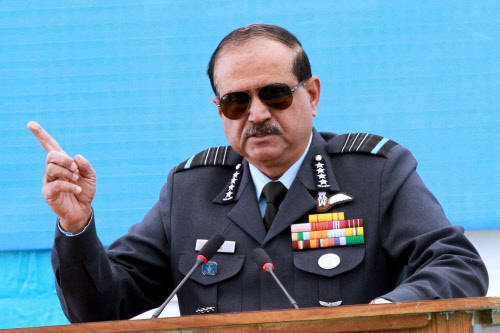WMD
Regular Member
- Joined
- Jan 2, 2013
- Messages
- 624
- Likes
- 794
An eagle in borrowed feathers
There have been strong public reactions to revelations in this newspaper last week about the Indian Air Force's (IAF's) advocacy of the import of a Swiss basic trainer aircraft, the Pilatus PC-7 Mark II. In 2009, the IAF lowered at least 12 important performance requirements, handing Pilatus a contract worth Swiss Franc 557 million (Rs 3,606 crore) for 75 trainers. And early last month, Air Chief Marshal N A K Browne, the IAF chief, wrote personally to Defence Minister A K Antony recommending that Hindustan Aeronautics Ltd (HAL) be ordered to halt the indigenous design and manufacture of 106 basic trainer aircraft, and the Swiss company be asked for 106 more PC-7 trainers worth at least Swiss Franc 645 million (Rs 4,226 crore) at current prices.
Sadly, most responses missed the real issue, either castigating the IAF for corruption, or insisting that the Pilatus PC-7 Mark II is an excellent choice for the IAF. The correct decision can also be a corrupt one, as the Bofors scam reminds us. But the big question is: with both the IAF and HAL crucial for Indian military aerospace, how can a working relationship be forged?
The IAF believes HAL is incompetent, has a poor work ethic and cannot design and build a basic trainer, a relatively simple aerospace task. The IAF allows HAL to build, maintain and overhaul its frontline combat fleet, but alleges – with some justification – that HAL merely knocks together Russian kits and delivers aircraft with dangerous deficiencies. But the IAF also accepts, albeit tacitly, that HAL has areas of genuine excellence – having played an important role in developing the Tejas Light Combat Aircraft (LCA), which it will mass produce; having designed the Dhruv Advanced Light Helicopter (ALH), in service with the army and air force; and having undertaken the challenging development of a Light Combat Helicopter (LCH).
HAL's view of the IAF is as problematic. While accepting the air force's technical competence, there is growing derision at the IAF's preference for imports. Even mid-level HAL engineers talk about air marshals who benefit from cosy relationships with foreign vendors.
This chasm must be bridged. Air Headquarters must engage HAL across the board and, as the user and senior partner, take ownership of projects like the HTT-40 and the LCA, and drive them to a successful conclusion. This will involve putting officers on the shop floor and (horror of horrors!) getting grease on those fighter pilot kid gloves.
Frustrated IAF officers have deluded themselves into believing that placing an air marshal, serving or retired, at the head of HAL will magically transform that company. That conclusion stems from the navy's successful indigenisation programme, in which Indian shipyards are building 46 warships of the 47 under construction. All three major defence shipyards – Mazagaon Dock Ltd, Mumbai; Garden Reach Shipbuilders & Engineers, Kolkata; and Goa Shipyard Ltd – are headed by retired admirals.
But the IAF is missing the wood for the trees. The navy's indigenisation programme starts with a consensus that buying foreign-built warships undermines budgets and capabilities. Given this co-operative ethos, it is unsurprising that defence shipyards tend to be headed by retired admirals.
When the navy wants a new class of warships, it begins by selecting an Indian shipyard to build it; the directorate of naval design creates a conceptual design and works with the shipyard to translate that into a detailed design; the directorate of indigenisation co-ordinates with industry to ensure that as many systems as possible are sourced from India; the navy allocates the budget and the shipyard rolls out the warships. Indigenous warships are often late and there are occasional quality issues. But the navy gets its home-designed warship at less than the global price. And each time a spare part is used, each time a refit or upgrade is carried out, more money is saved. Over its service life of three decades, the cost of an Indian warship comes to less than a quarter of one bought abroad.
This would be equally true of indigenous aircraft, but the IAF – devoid of any ethos of indigenisation, and with no structures to promote it – looks abroad at the first instance. When HAL-built HPT-32 trainers began crashing due to a flawed fuel system, the deaths of 19 pilots in 17 crashes over two decades took the IAF to Pilatus for a foreign replacement. But there is no comparable urgency in replacing MiG fighters, where the figures over the last four decades are truly devastating – of 872 MiGs in the IAF, 482 have crashed, killing 171 IAF pilots, 39 civilians and eight people from other services, according to figures tabled in Parliament.
Why has the IAF not grounded and replaced these dangerous and outdated aircraft, like it did with the HPT-32? The answer, say sceptics, is that the primary replacement for the MiG-series fighters is the indigenous Tejas fighter. Even though it is utterly safe (no Tejas has ever crashed, fingers crossed), there is no "incentive" to quickly buy the Tejas in large numbers.
It is time for Mr Antony to call in the air chief and bluntly say that the days of importing fancy fighters for lakhs of crores of rupees are over. Vapid banalities like "We will provide our brave jawans with the best equipment in the world" encourage IAF buying sprees like the Rafale and the Pilatus. The day Mr Antony musters the political courage to tell the IAF and the army that – like the navy – they will fight with whatever equipment they build, India will have taken its first step towards becoming a military power, with a functional defence industrial base.
An eagle in borrowed feathers | Business Standard




